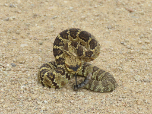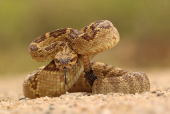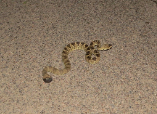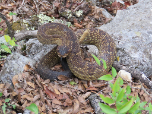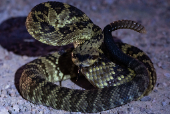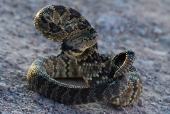Western Black-Tailed Rattlesnake (Crotalus molossus)
Description: This medium-sized species averages from 30 to 42 inches in length. The females tend to be larger than the males. They range in color from yellows and olive greens to browns and black. As their name implies, one of their most distinguishing features is, despite variations in body color, entirely black tail scales. Often, this rattlesnake has a black band across its eyes extending diagonally down to the corners of its mouth, forming a sort of facial 'mask'.
Like other rattlesnakes, C. molossus has a rattle composed of keratin on the end of its tail. Each time the snake sheds its skin, a new segment is added to the rattle. A snake can shed its skin several times a year, and the rattle is fairly fragile and can be broken, so that the length of a rattlesnake's rattle is not an accurate measure of its age, unless the terminal button is intact.
Habitat: The species' habitat includes rocky areas (rock slides, outcrops, canyon slopes, areas near cliff, stream courses), with vegetation ranging from arid tropical scrub, tropical deciduous forest, mixed boreal-tropical forest, paloverde-cactus-thorn bush associations, oak-grass savanna, and mesquite grasslands to chaparral and the pine-oak and pine-fir belts. In Arizona and northern Mexico, this snake often occurs in rocky areas in pine-oak association. A population in southeastern Arizona frequented rocky areas but used arroyos (dry creeks) and creosote bush flats in late summer and autumn (fall). Other habitats include creosote bush-covered hills, grassy prairie, giant-dagger flats, and the vicinity of abandoned buildings. This species occupies a wide range of habitats in Mexico, where at the southern end of the range habitats include pine-oak, oak savanna, sweet-gum/oak forest, and mesquite grassland. Refuges during inactivity include rock crevices, caves, animal burrows, or wood rat houses. This snake is mostly terrestrial but sometimes climbs into trees or bushes.
Range: The black-tailed rattlesnake is found in the southwestern United States in Arizona, New Mexico and west and central Texas, and Mexico as far south as Oaxaca.
Found in these States:
AZ |
NM |
TX
Venom: The venom of the C. molossus is primarily hemotoxic, like that of most crotalids. However, it is only about two-thirds as toxic as western diamondback venom and is generally not fatal to humans. CroFab antivenom is often used to treat bites. Crotalus molossus has larger venom glands than most rattlesnakes in its region. Because its venom is less toxic than that of most other crotalids, it needs to inject large quantities into its prey to be effective.
Diet: All rattlesnakes are carnivorous, their primary food sources being rodents, other small mammals, birds, and small reptiles (such as small lizards).
Reproduction: Breeding occurs in the spring when males follow the pheromone trails of the females. Copulation can sometimes last for hours and occur multiple times over a period of days. After mating, the male often stays near the female for several days to prevent any other males from mating with her. The female gives birth to live young in the summer, and the babies stay with the mother only until they wander off on their own, usually in less than a day or two. Females are believed to breed every year, and can have litters as large as 10-12 young but usually averaging four to six. Their lifespans average 15–20 years.
Status: Listed as Least Concern in view of its wide distribution, presumed large population, and because it is unlikely to be declining fast enough to qualify for listing in a more threatened category.
Subspecies: Three, with just one found in our region:
Northern Black-tailed Rattlesnake - (Crotalus molossus molossus)
Mexican Black-tailed Rattlesnake - (Crotalus molossus nigrescens)
Oaxacan Black-tailed Rattlesnake - (Crotalus molossus oaxacus)
»» Kingdom: Animalia - Animals
»» Phylum: Chordata - Chordates
»» Subphylum: Vertebrata - Vertebrates
»» Class: Reptilia - Reptiles
»» Order: Squamata - Scaled Reptiles
»» Suborder: Serpentes
»» Clade: Colubroides
»» Family: Viperidae - Vipers
»» Genus: Crotalus
»» Species: Crotalus molossus - Western Black-Tailed Rattlesnake
»» Subspecies:
»» Crotalus molossus molossus - Northern Black-tailed Rattlesnake
»» Crotalus molossus nigrescens - Mexican Black-tailed Rattlesnake
»» Crotalus molossus oaxacus - Oaxacan Black-tailed Rattlesnake
This article uses material from the Wikipedia article "Black-Tailed Rattlesnake", which is released under the Creative Commons Attribution-Share-Alike License 3.0. Content may have been omitted from the original, but no content has been changed or extended.
|



